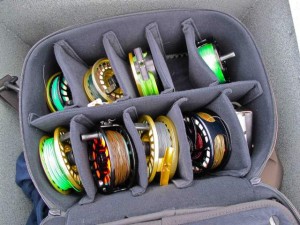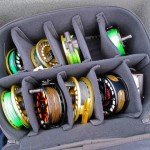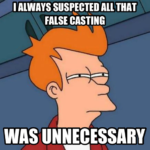A point that can be very confusing to someone who is just getting started in fly fishing is that lines come in different tapers. By this we mean that the line has a shape to it that means that it is not an even thickness or diameter along its length. The reason that this is the case is that it is easier to cast a line that has more weight towards the end of the line, as the weight at the front pulls the line forward more easily. There are however several different styles of fly fishing line that suit different situations.
Weight forward lines.
Most people when they start in fly fishing choose a line that has a weight forward pattern. As the name says, most of the weight is toward the casting end of the line, for the reasons we outlined above – that is to make it easier to cast. This type of line is good for casting heavier flies and for casting in heavier winds. However as it is the tip of a line that tends to wear out first, you can’t reverse this type of line to use both ends. This makes it less economical. It is also harder to make delicate presentations with a weight forward fly fishing line as the extra weight at the front can make the line splash down harder, making it easier to spook the fish.
Double taper fly fishing line.
With a double taper line, the thickest part of the line is situated in the middle of the line. This makes it harder to cast compared to a weight forward line, but the thinner tip makes it easier to make delicate presentations of the flies, particularly small light dry flies. As a result you are less likely to spook a fish with a double taper line. They can also be reversed meaning you get to use both ends of the line, making the line last longer. These lines are better for more advanced fly fishers.
Shooting lines.
These lines have a a very heavy and short thickened section at the tip which makes it easier to do longer casts or cast into heavy winds. It will often be tied on to another section of thinner fly line or monofilament. This is a more specialised type of line that most beginners will not need.
 Saltwater fly fishing lines.
Saltwater fly fishing lines.
These types of fly fishing lines are heavier and designed for casting the large flies that are commonly used in saltwater fly fishing. They are similar to a weight forward line, but the heavier section at the front is shorter, similar to a shooting line. As light presentation of the fly is less important in this type of fly fishing, the weight is less of an issue. As this branch of the sport has become popular, these lines have become better known.
Level taper lines.
These types of fly fishing lines are perhaps misnamed as they do not have a taper on them at all. This makes them hardest to cast however they are very economical as the lack of a taper means you can use trim the ends to keep it fresh. Their difficulty in casting however means that they are really only for experienced fly fishers.
In summary therefore, most people start with a weight forward fly fishing line, and progress to one of the other types as their experience and casting ability improves.

 Saltwater fly fishing lines.
Saltwater fly fishing lines.
